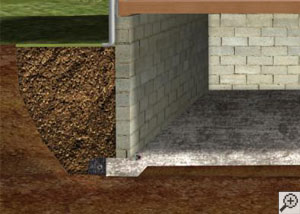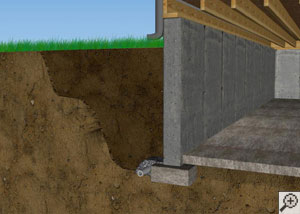Keeping Water Off A Monolithic Floor
How To Keep Water From Flooding Your Monolithic Floor

DryTrak® is an above-floor drain system that collects water from the wall-floor joint and directs it to a sump pump.
A gap along the top can also collect water leaking from the walls. Drilling holes in block walls enables this drain to collect water from voids in each block.
The Problem:
Your home is flooding and has a monolithic floor that needs to be waterproofed.
What Is a Monolithic Floor?
Monolithic foundations are found with both block and poured walls. The difference is that the floor and footing are poured in one piece instead of two. In other words, the floor is poured with thick edges to it -- and those thick edges are the footing.
Telltale Signs:
- Flooding at the joint where the basement floor meets the wall.
- Your walls are sitting on top of the floor, instead of extending beyond the floor.
How To Fix It:
We waterproof basements with monolithic floors by installing a specialized drainage system on top of the floor instead of underneath it -- our DryTrak® Basement Drainage System.
No matter what kind of basement walls and floor you have, we can dry your basement! Call us for a free wet basement repair estimate!

Typical foundations (top) are built in three pieces, with the wall resting on the footing. In this case, the slab floor rests around the edges of the floor.
Monolithic floors (bottom) have the floor and footing poured in one piece. In this case, the foundation wall rests on the floor/foundation slab.
Waterproofing Monolithic Foundations
With normal floors, we recommend jackhammering the entire perimeter of the floor, placing a subfloor drainage system, and restoring the floor with concrete.
In the case of a thick, monolithic floor, we do not recommend jackhammering the basement floor to install a subfloor system. Jackhammering a floor like this is very labor-intensive, and it will generate a great deal of dust during installation.
Instead, we install the DryTrak® Basement Drain System, which can be installed without jackhammering the floor.
DryTrak® is a heavy vinyl baseboard system, which is permanently epoxied to the surface of the floor, channeling water from the wall-floor joint to a sump pump system. It's the perfect solution for waterproofing monolithic foundations!
More about our DryTrak® Monolithic Floor Drain
Identifying A Monolithic Floor
There are a few easy ways that we use to tell if your home has a normal or monolithic floor.
If your home has concrete block walls: Concrete blocks are approximately 8" high, and stacked from bottom to top. Our contractor will measure the bottom block to see how tall it is. If there's 5" visible, then your floor is three inches thick. If all 8" of the block are visible, then we know the wall is resting on top of the floor, and that you have a monolithic floor.
If your home has poured concrete walls: We'll use a tool to make a small scrape at the location of the wall-floor joint. If the tool enters horizontally, we know that the wall is sitting on top of the floor, and you have a monolithic floor.
We Waterproof Monolithic Floors!
We have tried and true methods of waterproofing wet basements -- no matter what kind they are. Our basement waterproofing systems have been used in tens of thousands of basements throughout the United States and Canada for more than 20 years.
We'd like to offer a free, written foundation waterproofing estimate to any homeowner in our service are with a wet basement. Our free estimates include an on-site inspection, written cost estimate, a personal consultation, and a copy of our full-color waterproofing book. If you'd like to schedule an appointment with one of our experts, call or e-mail us today!
Looking for a price? Get a no cost, no obligation free estimate.
